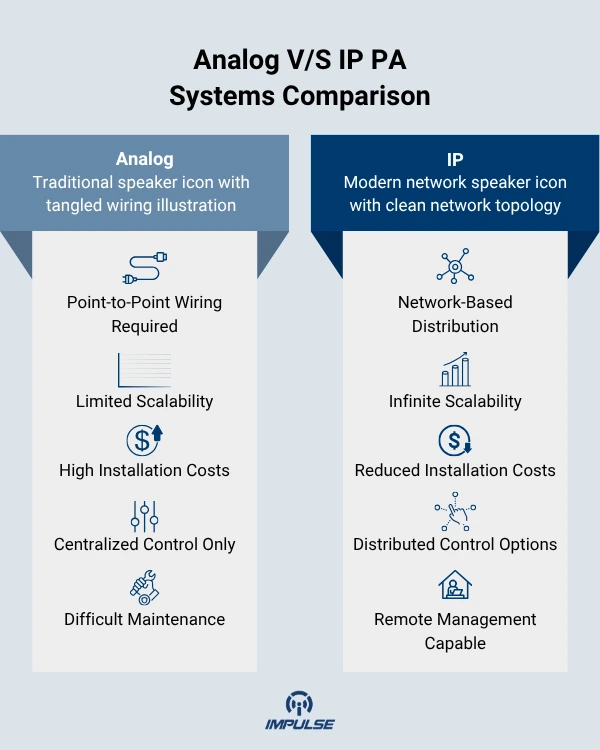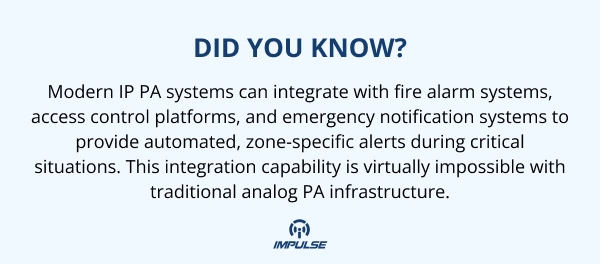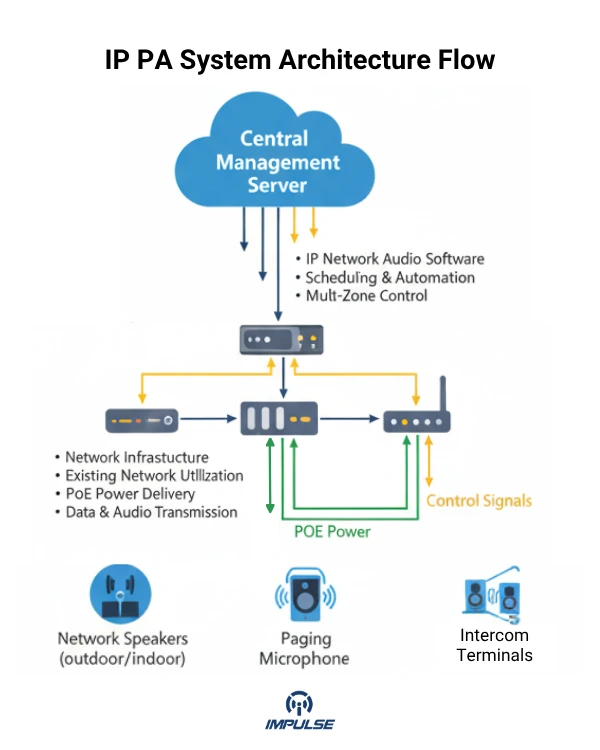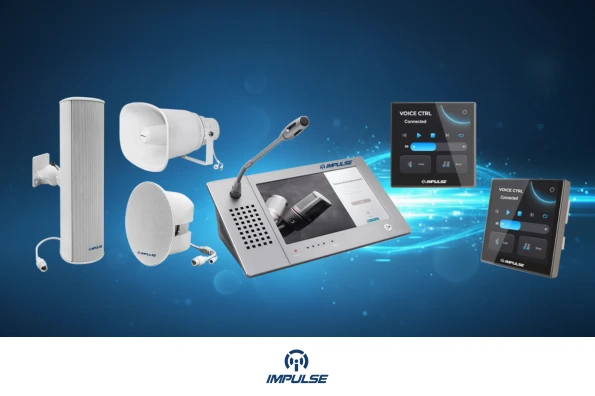The landscape of public address systems has undergone a revolutionary transformation in recent years. Organizations worldwide are transitioning from conventional analog PA infrastructure to sophisticated IP-based PA systems that leverage existing network architecture. This paradigm shift isn’t merely about upgrading hardware it represents a fundamental reimagining of how businesses communicate, manage emergencies, and maintain operational efficiency.
Traditional analog PA systems have served organizations faithfully for decades, but they come with inherent limitations that modern enterprises can no longer afford to ignore. The reduction in maintenance, ease of upgrades, and elimination of costly rewiring efforts make IP PA systems a cost-effective choice for businesses in the long run. As we delve deeper into this technological evolution, you’ll discover why IP public address systems are becoming the gold standard for educational institutions, corporate campuses, transportation hubs, and public venues.

Understanding the Core Differences: Analog vs. IP PA Systems
The Legacy of Analog PA Technology
Traditional analog PA systems operate through dedicated wiring that connects speakers, amplifiers, and control panels in a point-to-point configuration. Each speaker zone requires separate cabling, which not only increases installation complexity but also limits scalability and flexibility. These systems typically rely on centralized control rooms where operators must physically access equipment to make announcements or adjustments.
The technical constraints of analog systems become apparent when organizations need to expand coverage areas or modify zone configurations. Every change necessitates additional cabling, amplifiers, and potentially disruptive installation work that can impact daily operations.
The IP PA Revolution
IP public address systems fundamentally transform this approach by transmitting audio as digital data packets over standard TCP/IP network protocols. This architecture enables remarkable versatility and functionality that analog systems simply cannot match. The IP paging system utilizes the existing network to distribute sound all over the organization, which means organizations can leverage their current network infrastructure investment.
Modern IP PA solutions from Impulse CCTV, such as the IP Network Audio Software , serve as the nucleus of these advanced systems, providing centralized management, scheduling capabilities, and seamless integration with other building management systems.

Technical Advantages of IP-Based PA Systems
Superior Audio Quality and Distribution
IP audio systems deliver pristine digital audio quality that remains consistent regardless of distance from the source. Unlike analog systems where signal degradation occurs over long cable runs, digital audio transmission maintains fidelity throughout the network. The Network Outdoor Waterproof Column Speaker exemplifies this advantage, featuring built-in dual woofers and a tweeter that deliver crystal-clear audio in outdoor environments while being powered by PoE switches with +48V PoE capabilities.
This Power over Ethernet (PoE) functionality eliminates the need for separate power supplies at each speaker location, dramatically simplifying installation and reducing infrastructure costs.
Scalability and Flexibility
The shift to IP-Based PA Systems offers numerous advantages for modern businesses including reduced infrastructure requirements, lower installation costs, and decreased maintenance expenses. Organizations can add new speakers or zones simply by connecting devices to network switches, without running dedicated audio cabling throughout facilities.
The IP Audio Controller with LCD Touch Screen demonstrates this flexibility by supporting multiple audio source inputs including server streams, local SD card content, and Bluetooth sources enabling administrators to stream customized content to designated zones effortlessly.
Centralized Management and Control
Modern IP PA infrastructure provides unprecedented control capabilities through intuitive software interfaces. The Desktop Intercom Paging Microphone with 7-inch Touch Screen offers a start-up time of less than 1 second with a built-in speaker for monitoring, enabling operators to make quick announcements while maintaining audio quality assurance.

Integration and Convergence: The Future of Communication
Multi-Network Convergence
The IP PA Intercom-based System represents the pinnacle of communication convergence, integrating computer networks, PSTN telecommunication networks, and mobile communication networks into a unified platform. This comprehensive system enables interconnection between LAN, WAN, PSTN, and mobile networks, facilitating convenient voice, video intercom, and broadcast functions at significantly reduced costs.
This convergence capability transforms PA systems from simple announcement tools into comprehensive communication platforms that support multiple use cases including emergency notifications, routine announcements, intercom functionality, and even visitor management.
Emergency Response Optimization
In critical situations, every second matters. IP-based PA systems excel in emergency scenarios by allowing quick call processing and system resets that can be triggered automatically or manually from multiple locations. The One-Key For Help Intercom Terminal provides instant communication capabilities during emergencies, enabling personnel to initiate help requests with a single button press.
The distributed nature of IP systems means announcements can be made from any authorized network-connected device, eliminating single points of failure that plague centralized analog systems.

Cost-Benefit Analysis: ROI of IP PA Systems
Reduced Installation Expenses
Traditional analog PA installation requires extensive labor for pulling dedicated audio cables, installing amplifiers at strategic locations, and configuring complex wiring topologies. IP PA systems leverage existing network infrastructure, dramatically reducing installation time and material costs. Organizations with established network infrastructure can achieve installation cost reductions of 40-60% compared to analog alternatives.
Long-Term Maintenance Savings
The centralized management capabilities of IP systems enable remote diagnostics, firmware updates, and configuration changes without dispatching technicians to individual speaker locations. This remote management capability significantly reduces ongoing maintenance expenses while improving system reliability and uptime.
Energy Efficiency
PoE-powered devices like the Network Outdoor Waterproof Column Speaker consume power only when actively transmitting audio, unlike analog amplifiers that typically operate continuously. This efficiency translates to measurable energy savings over the system’s operational lifetime.
Implementation Considerations and Best Practices
Network Infrastructure Assessment
Before deploying an IP PA system, organizations should conduct thorough network assessments to ensure adequate bandwidth, proper Quality of Service (QoS) configuration, and appropriate switch port capacity. While IP audio requires relatively modest bandwidth typically 64-256 Kbps per stream proper network design ensures audio quality remains consistent even during high network utilization periods.
Zone Design and Coverage Planning
Effective PA zone design considers architectural acoustics, ambient noise levels, speaker dispersion patterns, and intended coverage areas. The Network Outdoor Waterproof Column Speaker provides ideal coverage for outdoor applications including schools, gymnasiums, squares, parks, parking lots, railway stations, airports, villas, and supermarkets, making it an excellent choice for diverse environmental conditions.
Redundancy and Reliability
Mission-critical applications require redundant power supplies, backup network paths, and failover capabilities. Modern IP PA architectures can incorporate these redundancy features more cost-effectively than analog alternatives, ensuring continuous operation even during component failures.
User Training and Adoption
The sophisticated capabilities of IP PA systems require appropriate user training to maximize value. The intuitive interfaces provided by devices like the IP Audio Controller with LCD Touch Screen\) simplify operations, but comprehensive training ensures staff can leverage advanced features including scheduling, zone management, and emergency procedures.
Real-World Applications Across Industries
Educational Institutions
Schools and universities benefit tremendously from IP PA technology’s ability to deliver bell schedules, campus-wide announcements, and emergency notifications with zone-specific precision. The Desktop Intercom Paging Microphone with 7-inch Touch Screen (IMP-PAS-6490) enables administrators to quickly communicate with specific buildings, floors, or outdoor areas without disrupting unaffected zones.
Corporate Campuses
Large corporate environments leverage IP PA systems for routine announcements, visitor notifications, evacuation procedures, and background music distribution. The integration capabilities of the IP PA Intercom-based System (IMP-IPNPA-ISERV) enable seamless coordination with access control and building management platforms.
Transportation Hubs
Airports, railway stations, and bus terminals require reliable, intelligible public address capabilities for passenger information, security announcements, and emergency evacuations. The weatherproof construction and high-fidelity audio of solutions like the Network Outdoor Waterproof Column Speaker (IMP-PAS-6700) ensure clear communication in challenging acoustic environments.
Retail and Hospitality
Shopping centers, hotels, and entertainment venues use IP PA infrastructure for promotional announcements, background music zoning, and customer service enhancements. The One-Key For Help Intercom Terminal (IMP-PAS Intercom Terminal Series) provides instant communication for staff assistance requests and security coordination.
Conclusion
The transition from analog to IP-based PA systems represents more than a technological upgrade it’s a strategic investment in communication infrastructure that delivers immediate cost savings, enhanced functionality, and long-term scalability. The shift to IP-Based PA Systems offers numerous advantages including reduced infrastructure requirements, lower installation costs, and decreased maintenance expenses with centralized management capabilities.
Organizations implementing IP public address solutions from Impulse gain access to enterprise-grade audio distribution, seamless integration with existing systems, and future-proof architecture that adapts to evolving communication needs. Whether you’re managing a corporate campus, educational facility, transportation hub, or public venue, IP PA technology provides the reliability, flexibility, and functionality that modern operations demand.
The comprehensive product ecosystem from Impulse including the IP Network Audio Software as the system nucleus, robust outdoor speakers, intuitive control interfaces, and versatile intercom terminals delivers complete solutions tailored to diverse application requirements. These integrated systems ensure quick call processing and system resets while maintaining the highest standards of audio quality and operational reliability.
Upgrade from outdated analog PA systems and unlock enhanced communication with Impulse’s IP-based solutions. Our technology reduces costs while improving functionality. Contact us today for a customized assessment and tailored IP PA solution that fits your needs and budget.


